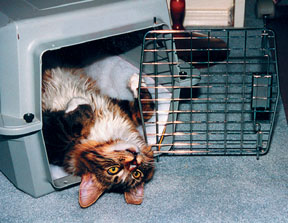You need to take your cat to the veterinarian for a checkup. When you retrieve the cat carrier from the closet, your cat disappears. The ensuing chase tires you and stresses your cat, making his heart beat faster and possibly elevating his temperature. Sound familiar?

288
For many cat owners, getting their cats into a carrier is a harrowing experience but necessary for veterinary visits, emergency evacuations, or moving to a new location.
You may want to put your cat in a carrier to keep her from escaping when painters or housekeepers come, says Ellen Lindell, VMD, board certified by the American College of Veterinary Behaviorists and columnist for CatWatch.
Why wait until an emergency arises? Accustoming your cat to being in the carrier simply takes foresight and training.
Accentuate the Positive
Cats often dont like being in a carrier because they fear confinement. Cats are not taught to be contained, says Dr. Lindell.
To acclimate your cat to being in a carrier, you need to make being in it a positive experience. Condition him so he doesnt mind getting in, says Dr. Lindell. Place the open carrier somewhere in your home that is easily accessible to him but out of the way of heavy traffic. Put your cats bed or favorite blanket in the carrier so he will want to get into it. Put bedding in the carrier that is soft and washable, and that your cat likes, says Dr. Lindell. Set it up so that he can get under if he wants to hide.
Sprinkle some catnip in the carrier or leave his favorite toy inside it. He will view it as not so scary if theres a pleasant association with good things inside, says Dr. Lindell.
When you are home, offer him a special treat when he gets into the carrier on his own or offer him a small meal in the carrier. Just make sure he is eating and not losing a meal because its in the carrier, says Dr. Lindell. Make it an extra meal and let the cat know eating in the carrier is an alternative.
Why Size Matters
Many cat owners buy kitten-sized carriers when they first adopt a cat, but dont get a larger one as the cat grows into adulthood. Your cat may be more inclined to get into a carrier if it is larger. Cats need to be able to stand up and turn around in a carrier, says Dr. Lindell.
When deciding what size carrier to purchase, the length of time the cat will be in it is a consideration. If you are moving, for example, the carrier may need to be large enough for a litter box and water bowl so he can sit up, stretch and use the box if he needs to.
But if it is too big, it can be dangerous for traveling as the cat can get thrown against the sides, says Dr. Lindell.
Once your cat is used to getting into his carrier, train him to come by using food rewards or a clicker. Practice calling him to his carrier even when you dont have to take him anywhere. When you use the carrier only on those times when you need to get your cat to a veterinary appointment, you inadvertently reinforce your cats dislike of being in it.
For many cats, the only time they go in a carrier is to do something they dont like, such as going to the veterinarian, says Dr. Lindell. And if you call a cat to do something they dont like, they wont trust you in the future.
Some cats may benefit from going on short trips in the carrier after which they just come home and have a snack or treat. It depends on the cats temperament, says Dr. Lindell. If the cat is fearful, hes not likely find a lot of pleasure in that. Home exercises may be enough.
Training your cat to come to his carrier will make it less stressful for both of you. Conditioning doesnt teach him to like being in the carrier, but it teaches him to go to it, says Dr. Lindell.



